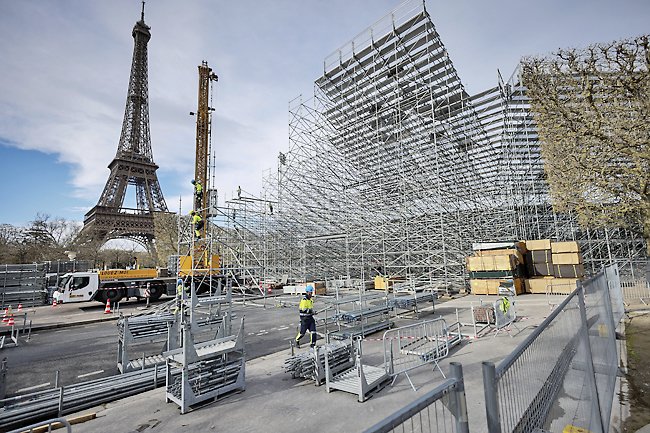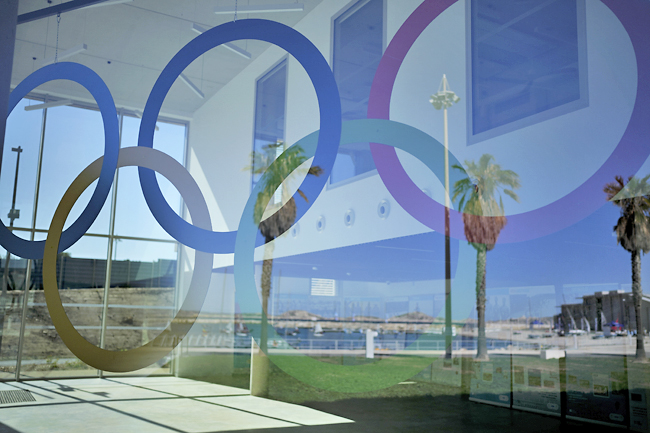PARIS (AP) – Of all the decisions Paris Olympics organisers made about where to hold each sport, sending surfing competitions to the other side of the world – in the Pacific waters of Tahiti – provoked the strongest reactions. Tahitians and others railed against the building of a new viewing tower on Teahupo’o reef because of fears it would hurt marine life.
But organisers say it wasn’t just the world-class waves that lured them to the French territory 16,000 kilometres away. Paris Olympic officials had set an ambitious target of halving their overall carbon footprint compared with the 2012 London and 2016 Rio Games.
Tahiti’s surfing reef is too far offshore for fans to see the action clearly from the beach, so organisers said they calculated that most would watch on television instead of taking flights, a major source of carbon emissions.
And fewer spectators, they said, would require little new construction, another key emissions source.
“We actually did the maths,” said director of environmental excellence Georgina Grenon for the Paris Games.
“There was less impact in Tahiti compared to other metropolitan areas.” Tahiti’s selection provides a window into Games organisers’ approach to hitting their goal of reducing emissions, the driver of climate change. It also underscores an inherent tension in the drive for sustainability: There are tradeoffs, and reducing emissions doesn’t necessarily mean preserving the environment.




Organisers’ goal is to limit emissions to 1.58 million metric tonnes of carbon dioxide (CO2) equivalent for the July 26 to August 11 Games and Paralympics that follow.
That’s still a lot of pollution – equal to that of about 1.3 million economy passengers flying one way from New York to Paris on Boeing 787 jets, according to myclimate, a climate and sustainability consultancy. It’s a lot less, however, than the footprint of previous Games.
Organisers say they’re thinking about the Games’ future, not just the planet’s. Fewer cities are volunteering to spend billions on infrastructure that sometimes falls into disuse. Paris and the next host, Los Angeles in 2028, were the only cities left in the race when picked in 2017. For organisers, hosting less-wasteful Games is key, along with including more inclusive, youth-oriented events such as skateboarding.
Paris is under additional pressure to be a sustainable model: The city hosted the 2015 UN climate talks that resulted in the Paris Agreement, the most significant international climate accord to date. Delegates agreed the world should limit average global temperature rise to two degrees Celsius above that of the 1850s, and ideally cap it at 1.5 degrees – a goal looking increasingly unattainable.
Independent experts say Paris appears to be decarbonising in the systematic ways businesses do: Calculate total emissions, then start cutting, including myriad small CO2 savings that add up significantly. Organisers targetted reductions across three categories: construction, transportation and operations.
“They seem to be taking a very thoughtful approach,” said Adam Braun of Clarasight, which builds carbon-planning software for companies. “They are trying to do something that is indicative of how many organisations will be holding themselves accountable.”
The biggest break from previous Games is in construction. Organisers say 95 per cent of facilities are existing or will be temporary. Two new structures were deemed unavoidable: The Olympic Village, to house athletes and later become housing and office space, and the aquatics centre in Paris’ disadvantaged northern suburbs.
Using wood, low-carbon cement, and salvaged materials helped reduce emissions by 30 per cent compared with traditional methods, Grenon said.
Reductions in operations include food. The average meal in France – restaurant- or home-prepared – produces about two kilogrammes of CO2, said the Games’ catering head Philipp Würz.
Paris aims to halve that by sourcing 80 per cent of ingredients locally, cutting transport emissions, and offering spectators 60 per cent plant-based foods.
Winning minds as well as tastebuds could take work. “Locally grown food, and supporting local farmers, are beautiful things,” tennis player Victoria Azarenka said. But “when people are doing these big gestures, I’m not fully convinced of the impact,” she added of Paris’ overall climate efforts. Another emissions-savings source is energy. Energy will represent only one per cent of emissions, organisers said.
They intend to use 100 per cent renewable power from wind and solar farms, plus solar panels on some venues. – John Leicester






